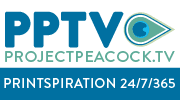Now more than ever I believe it’s time for companies that make print equipment and products to re-examine their strategy and start communicating directly to the people who have influence and control over where and how print jobs are produced.
Recently, I have discovered something pretty amazing along my trade show travels and interactions with some of the big name equipment companies out there – they don’t know or understand what I do. I am not referring to my work at PMC; A few viral videos have made me somewhat recognizable, social media has given me some huge exposure, and it always helps to have PRESS on your event badge when stopping to talk with people. I am referring to the duties and responsibilities of a Print Production Manager and how we fit into their sales process.
I come from the Advertising Agency world. I am a Print Producer, I am NOT a Print Buyer, and the more I am called a buyer and agree to that term to make things simpler for people to understand, the more I realize I am contributing to the extinction of that role and the credit it deserves.
So let’s start here…
A Print Producer is part of the creative team. We can be called upon to present ideas for projects before they start, or try and fit the concept into something that can print correctly if we come in later on. We work directly with designers and art directors on choosing paper, color, printing techniques, finishing and bindery options. In cases where there is no official Art Buyer, we purchase art, photography and stock photography, and in more extreme cases even set up photoshoots. We research and hire retouchers and pre-press services when those functions aren’t available in house, or just better to use out of house depending upon the job. As a Production Services Director, I have hired freelance creatives, proofreaders and studio personnel as well as other Print Producers and Traffic Managers. One Christmas as a matter of fact headhunters sent me gift baskets to thank me for all the business.
A Print Producer is part of the Account Management team. We are responsible, along with our counterparts in Traffic, for keeping projects on time, and on budget no matter how many of them are flying through or what they entail. We create status reports and hold status meetings, talk to the clients when needed or asked, and more often than not when something goes wrong we bear the brunt of that blow.
A Print Producer is part of the Accounting team. We enter estimates into the internal system, issue PO’s and reconcile invoices all while painstakingly adhering to SOX standards so the Agency isn’t audited. We have to explain, and are required to provide detailed back-up documentation whenever the Agency has to cover costs due to issues or errors that makes the President Obama birth certificate hooplah seem like a Monday morning on Madison Ave. We get the calls from Printers/Print Service Providers when payments are outstanding and we are responsible for keeping our Agency and accounts in good standing whether it’s 9 days or 90 days overdue.
Now, let’s get to the Buying part. It’s an important part of my job but it fits in with everything above. It’s not just getting quotes and “buying” print. When I hear Print Buyer as it relates to what I do, I think of a Print Broker or someone buying printed materials, as well as office furniture, from a Procurement Department. To me “buyers” sit outside of the process and not within it as far as the creation of the work and INFLUENCE on what is created. This is where I think the biggest disconnect is when it comes to learning about machines, capabilities, and products and services that are out there, and why the big companies arent communicating, educating and marketing to us.
Pull Marketing is not a new concept, but now more than ever I believe it’s time for companies that make print equipment and products to re-examine their strategy and start communicating directly to the people who have influence and control over where and how print jobs are produced. I cannot recall EVER getting a brochure about a new Digital Press and what it can do, or even an Offset Press for that matter. I have never been asked, or included in any research in regard to how Print Producers learn about the different machines and their capabilities, or what factors we use to determine what we will print on. It’s now my assumption that the manufacturers focus on selling machines to Printers, and then leave it up to the Printers to sell us on using the machines. BIG MISTAKE.
I have great respect for Printers and I have always thought of them as Partners, not as interchangeable Vendors. But they have their own problems right now since the volume of work Print Producers (and Buyers) are sending to them has diminished. They are more focused on getting work, any work, and getting new accounts. Print Producers are bombarded with so many cold calls and packages and drop-ins at the office that the last thing we want to do is open that door and then be bombarded with endless follow-ups. The Print Partners we do communicate with might be using the same equipment for the last 5 years and not planning on upgrading anytime soon. With a few exceptions as there are Printers out there on a total education mission (see printForum), they are not going to tell us about any new machines, technologies or capabilities they don’t have to sell us – which makes total sense. So how does a Print Producer get that information?
Let me tell you who does it correctly… the Paper companies and the Design Software companies. In full disclosure Adobe is a site sponsor of PrintMediaCentr and for good reason… I LOVE THEM and always have. To me Adobe is more than a company; their products are part of my life and my work life. They communicate with me. Their marketing is cool. They know who their audience is. They provide education. They care.
Paper companies do it a little differently but with the same impact. New swatch books are an event at an Agency. They are all beautifully designed, show tons of techniques that INSPIRE Print Producers and Creatives to try them out (on their paper!) for our next projects, and almost every website I have visited provides detailed information on the best use for each individual stock, including things to watch out for. And not for nothing, but Paper Reps are pretty awesome too. They can help you with comps on actual stock, always make sure your swatch books are up to date, and never harass you. Paper companies help us do our jobs, show us what is possible, know who their audience is, provide education. They care. And when they send packages… well lets just say you can send out an email and get almost every Creative in a room to look without the lure of free food!
So why don’t the companies that make the machines we print on care about helping us or even informing us on basic level what they are sending out into the marketplace? Most Print Producers cannot attend trade shows (the Agency wont pay) and don’t have the time or inclination to drop by your website which, by the way is too technical for what we would want to know, so we aren’t your audience. I don’t receive cool marketing materials or packages showing me the possibilities of your machines that I can pass around to the Creatives so we can use in upcoming projects. You don’t invite me to see demonstrations, or to free seminars. You aren’t helping me add value to the work, the Agency or communicating with me. You aren’t part of my work life, or trying to be, so I am not seeking your products out by name.
As a group, Print Producers are a pretty loyal bunch. We stick with the people who help us, and the products and services that result in the best quality and in some cases even make our work lives easier. We want to know what is out there so WE are more valuable as employees as well as adding value to the work and for our clients. Teach me or show me something on Model XYG, I am going to seek out Model XYG out when it’s time to produce my work.
So to all the Machine Makers out there – PLEASE… Learn about us, talk to us, invite us places and send us cool stuff in the mail. PULL us into your marketing and let’s start a long term and mutually beneficial relationship! Just don’t call me a Buyer.












